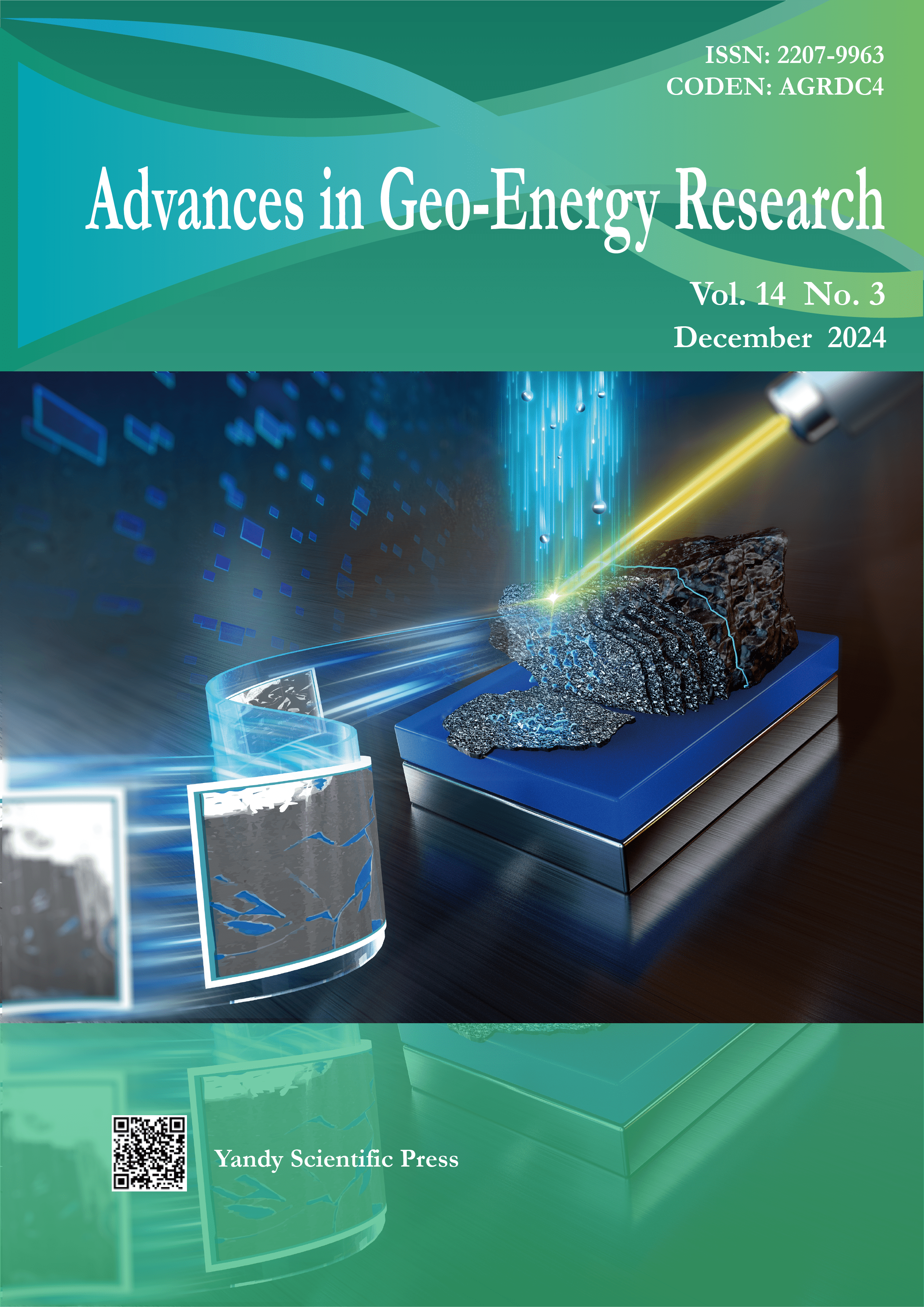Accurate stress measurement using hydraulic fracturing in deep low-permeability reservoirs: Challenges and research directions
Abstract
Although there is increasing recognition of the significance of deep in-situ stress measurement for the safe and efficient exploitation of geo-energy in deep low-permeability reservoirs, accurate measurement of deep stresses using the hydraulic fracturing technique still requires substantial enhancement. In this work, the major challenges in the precise hydraulic fracturing stress measurement in deep low-permeability reservoirs are pointed out, including high rock temperature, high pore pressure, fracturing mechanism, rock tensile strength, and drilling conditions. Under such circumstances, several future research directions are proposed accordingly. These involve the thermal-pore-elastic effect, downhole sensors and flow meters, appropriate indoor tensile strength test methods, new stress calculation methods, hybrid test techniques, and refined coupled numerical models. The future research recommendations will provide several fresh perspectives for geo-energy development in deep low-permeability reservoirs in subsequent stages.
Document Type: Perspective
Cited as: Li, P., Liu, Y., Cai, M., Miao, S., Dai, L., Gorjian, M. Accurate stress measurement using hydraulic fracturing in deep low-permeability reservoirs: Challenges and research directions. Advances in Geo-Energy Research, 2024, 14(3): 165-169. https://doi.org/10.46690/ager.2024.12.02
Keywords:
Hydraulic fracturing, in-situ stress measurement, deep low-permeability reservoirs, fracturing mechanism, rock tensile strengthReferences
AlTammar, M. J., Sharma, M. M. Effect of borehole pressurization scheme on breakdown pressure. Rock Mechanics and Rock Engineering, 2019, 52: 2709-2715.
Chang, C. D., Jo, Y., Oh, Y., et al. Hydraulic fracturing in situ stress estimations in a potential geothermal site, Seokmo Island, South Korea. Rock Mechanics and Rock Engineering, 2014, 47: 1793-1808.
Gan, Q., Elsworth, D., Alpern, J. S., et al. Breakdown pressures due to infiltration and exclusion in finite length boreholes. Journal of Petroleum Science and Engineering, 2015, 127: 329-337.
Haimson, B. C. The hydraulic fracturing method of stress measurement: Theory and practice, in Comprehensive Rock Engineering, edited by J.A. Hudson, Pergamon Press, Oxford, pp. 395-412, 1993.
Haimson, B. C., Cornet, F. H. ISRM suggested methods for rock stress estimation-Part 3: Hydraulic fracturing (HF) and/or hydraulic testing of pre-existing fractures (HTPF). International Journal of Rock Mechanics and Mining Sciences, 2003, 40: 1011-1020.
Lakirouhani, A., Detournay, E., Bunger, A. P. A reassessment of in situ stress determination by hydraulic fracturing. Geophysical Journal International, 2016, 205: 1859-1873.
Lee, M. Y., Haimson, B. C. Statistical evaluation of hydraulic fracturing stress measurement parameters. International Journal of Rock Mechanics and Mining Sciences and Geomechanics Abstracts, 1989, 26: 447-456.
Qu, X. J., Yang, L. W., Xue, X., et al. Prediction of the bottom hole geotemperature, formation pressure and formation fracture pressure of the Continental Scientific Drilling of Cretaceous Songliao Basin (SK2). Earth Science Frontiers, 2017, 24: 257-264. (in Chinese)
Rajabi, M., Tingay, M., Heidbach, O. The present-day state of tectonic stress in the Darling Basin, Australia: Implications for exploration and production. Marine and Petroleum Geology, 2016, 77: 776-790.
Sampath, K. H. S. M., Perera, M. S. A., Ranjith, P. G. Theoretical overview of hydraulic fracturing break-down pressure. Journal of Natural Gas Science and Engineering, 2018, 58, 251-265.
Schmitt, D. R., Haimson, B. C. Hydraulic fracturing stress measurements in deep holes, in Rock Mechanics and Engineering, edited by X.T. Feng, CRC Press, Boca Raton, pp. 183-225, 2017.
Su, Y. N., Lu, B. P., Liu, Y. S., et al. Status and research suggestions on the drilling and completion technologies for onshore deep and ultra deep wells in China. Oil Drilling and Production Technology, 2020, 42: 527-542. (in Chinese)
Wu, B. S., Gamage, R. P., Zhang, X., et al. An analytical thermo-poro-elasticity model for the mechanical responses of a wellbore and core during overcoring. International Journal of Rock Mechanics and Mining Sciences, 2017, 98: 141-158.
Yamashita, F., Mizoguchi, K., Fukuyama, E., et al. Reexamination of the present stress state of the Atera fault system, central Japan, based on the calibrated crustal stress data of hydraulic fracturing tests obtained by measuring the tensile strength of rocks. Journal of Geophysical Research: Solid Earth, 2010, 115: B04409.
Zhang, Y., Zhang, J. Lithology-dependent minimum horizontal stress and in-situ stress estimate. Tectonophysics, 2017, 703-704: 1-8.
Zoback, M. D. Reservoir Geomechanics. Cambridge University Press, Cambridge, 2007.
Downloads
Downloads
Published
How to Cite
Issue
Section
License
Copyright (c) 2024 Author(s)

This work is licensed under a Creative Commons Attribution-NonCommercial-NoDerivatives 4.0 International License.
